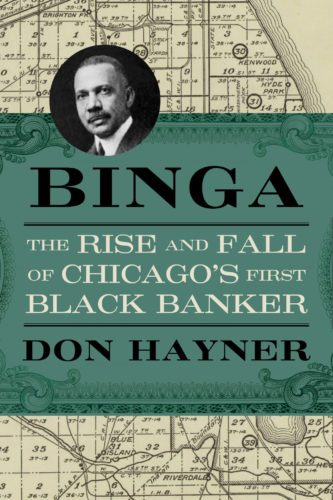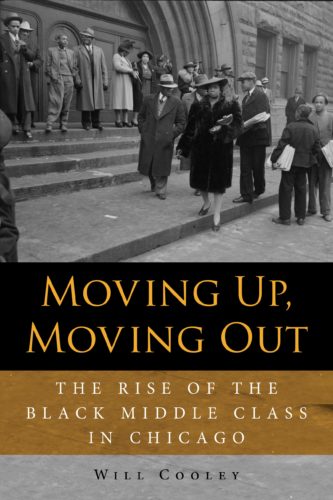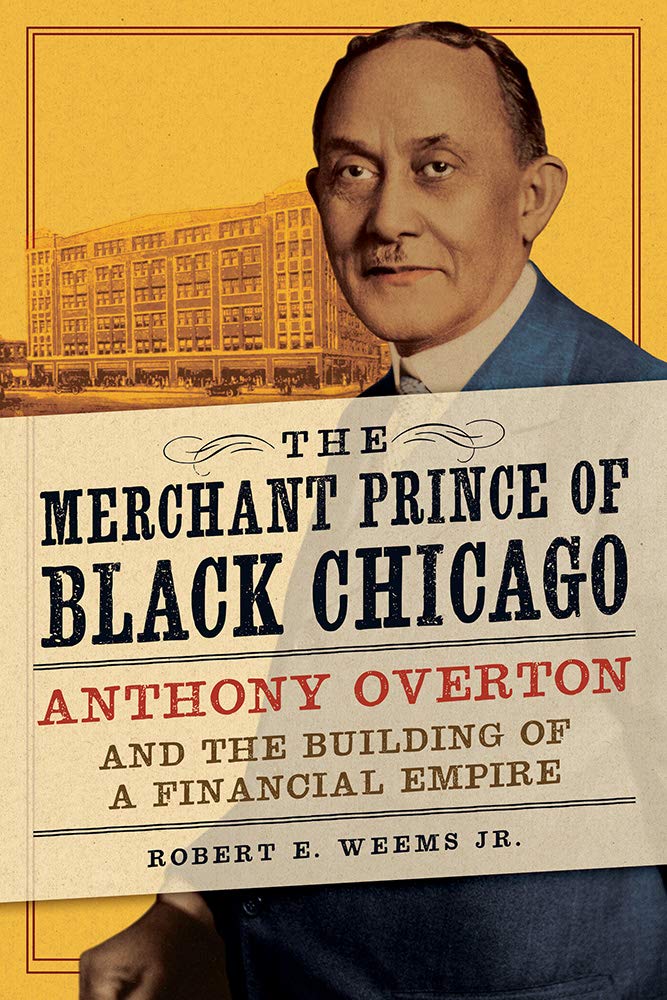“Money is a wonderful thing,” an editorial in The Half-Century Magazine declared in 1922. “If you have enough of it, the world voluntarily places a coat of white wash over your blackest crimes. Money opened the doors for some of the most exclusive places to the Jews. Enough money would blind the eyes of the white race to our own color.”
The Half-Century Magazine was established by Black businessman Anthony Overton as a forum for advertising his personal care products company. In 1922, Overton controlled a fortune of $300,000-$500,000 through his Bronzeville-based Overton Hygienic Manufacturing Company.Nearly 98% of his wealth would disappear in just two decades.
Three recent books, including a biography of Overton, trace the accumulation and loss of Black wealth on the South Side of Chicago in the first half of the twentieth century. The Merchant Prince of Black Chicago, by Wichita State University history professor Robert Weems Jr., provides a richly documented account of the life of Overton and his particular talent in advertising. In Binga: The Rise and Fall of Chicago’s First Black Banker, Don Hayner, the retired editor-in-chief of the Sun-Times, explores the life of Black banker Jesse Binga with storytelling that reads like a fast-paced novel. Both born around 1865, Overton and Binga’s lives intersected through their collaborations, their rivalries, and their downfalls, painting a rich picture of Black ambition in the first generation after emancipation. Moving Up, Moving Out, by Metropolitan State University historian Will Cooley, traces these patterns forward into time, diving into the battles for desegregation waged by middle-class Black Americans from the 1910s through the 1970s.
Together, the books cover over a century of Chicago history. But it is the 1920s—the so-called golden age of Black business—that rises to the fore. During the 1920s, Binga and Overton were at the height of their wealth and prominence. Their business empires included a newspaper, personal care products, life insurance, apartments, storefronts, two banks, and investments all across the South Side. They socialized at lavish Christmas parties with the who’s who of the city’s elite, and commanded respect in Black and white publications around the country.
The 1920s both set the bar for dazzling accomplishments in a segregated world and set the stage for how far these moguls would fall. Tracing to the root of the moment when the South Side became associated with Blackness, these revived stories dispel the narrative that the disparities in racial wealth we see today were natural and inevitable, and ask us to question the circumstances that led to their formation.
[Get the Weekly in your mailbox. Subscribe to the print edition today.]
In 1900, the Black population in Chicago was about 30,000 in a city of one million. But as waves of Southern migrants arrived in the coming decades, this population would double again and again. New arrivals to the city would find that most mainstream economic opportunities were closed to them: they could not join a union, learn a trade, work white collar jobs, or live outside the Black Belt, the chain of neighborhoods on the South Side that held most of the city’s Black residents in the 20th century.

But the growing Black population had another effect: enabling Black entrepreneurs to rise by catering solely to their own. Increasingly, an economically successful class of Black Chicagoans had to confront new questions: What does success mean in a world where most doors are still closed to you? And what are your responsibilities to other Black people, who face the same discrimination as you?
Anthony Overton and Jesse Binga represented two archetypes of success in the boomtime decades. Overton was considered a refined businessman and known as “a polished man with a regal bearing”; before arriving in Chicago from the South, he had gone to college and law school. He made his fortune selling face powder and makeup to Black women with a message akin to modern-day body positivity, telling Black women that they did not need to aspire to white standards of beauty and that they were inherently beautiful. As his wealth grew, Overton leveraged his success into broader financial ambitions, helping to open the Douglass National Bank in 1921 and founding the Victory Life Insurance Company in 1924.
Binga, on the other hand, was a polarizing figure. In Cooley’s history of housing in Chicago, Binga is portrayed as one of the worst slumlords. After coming to Chicago as a street peddler, he built a real estate empire by renting out rooms and subdividing apartments, capitalizing on Black population growth. He negotiated deals in white neighborhoods and, once the white tenants fled, charged new Black residents rents that were forty to fifty percent higher. By 1909, he was the landlord to over two thousand people.
Binga made his fortune as a Black real estate agent at a time when real estate was soaked with tension and violence. Caught between Black tenants who complained about his high rents and white people who resented his incursions, Binga himself appeared to simply believe that he was doing what he was supposed to as an American: making money off of opportunities. This belief in capitalistic exceptionalism led him to found perhaps the biggest symbol of Black wealth in the city: Binga Bank.
Then as now, the world of high finance, where fortunes are made, was seen as a critical piece of the struggle for racial equity. Banking was a powerful symbol of the path to a better future. Together, Binga and Overton controlled “36 percent of the combined resources of all Negro banks in the United States.” And for both men, banking was inseparable from a broader agenda for racial uplift. When asked for advice for other Black Chicagoans, Binga told them, “Learn business: Establish a credit: Provide for your own wants. That is my message to our group.”
Overton, meanwhile, made a forceful case against using white banks. When Black people deposited their money in white banks, he said, “These same Negro funds are loaned to white business institutions that likewise would not give employment to one of our race in any capacity. The Negro’s money is used to close the door of opportunity in his own face.”
Because of the rarity of their wealth and the smallness of the Black Belt, Overton and Binga inhabited much the same world, and both Hayner and Weems, Jr. bring it to life with a glittering array of side characters. Langston Hughes famously commented that “midnight was like day” on South State Street, as Bronzeville nightlife thrived in jazz clubs. Black business leaders navigated a lifestyle somewhere between that of policy kings, the Black heads of gambling enterprises, and those of white business leaders like Julius Rosenwald and Marshall Field III. Binga had a close relationship with Robert Abbott, the publisher of the famous Chicago Defender, and attended events with pioneering journalist Ida B. Wells. Booker T. Washington and W.E.B. DuBois appear throughout both books, exchanging letters and corresponding with the two Chicago bankers.
In Weems, Jr.’s book, the chapter on the Great Depression is entitled “What Goes Up Must Come Down.” The Great Depression ended this period of success, with the Binga State Bank closing in 1930 and the Douglass National Bank following in 1932. But while Overton’s reputation remained largely intact, Binga was accused and convicted of embezzling from his bank—a controversial charge that some felt was trumped up because of racism.
After decades of opulence, Binga spent nearly three years in prison in his seventies. Those who had trusted him—who had wanted to support a Black-owned bank—lost their life savings. But reading Hayner’s account, you come away with the distinct sense that Binga did not get justice. Caught up in the tide of the Great Depression, hundreds of banks failed—but not every bank president suffered the same fate. You question whether white members of the parole board could have done more for an old man who was in danger of dying in prison, and who was in jail for embezzlement but now controlled no financial assets. In prison, Binga was denied executive clemency, then denied parole the first time; it was a year and a half before his plea was heard again.
Hayner and Weems, Jr. portray their subjects with a fair hand, and Binga and Overton were both imperfect businessmen. They hired too many family members and did not observe strict rules between their many business enterprises; this habit of playing fast and loose with legal and accounting technicalities became especially problematic for Binga. But it’s not hard to see why they did business the way they did—they sought to be singularly in control, because they had singularly succeeded against impossible odds.
Were their mistakes impossible to overcome? How did other business empires survive and rebuild after crises when Black entrepreneurs could not? The first answer we find in overt racism. At the critical juncture when the Binga Bank may have been saved, the Chicago Clearing House Association refused to lend Binga the funds, even though he was entitled to assistance as a member of the group. After Binga personally went to him for help, Melvin Traylor, the head of the association, “was later quoted as saying, ‘The Binga Bank was a little [racial slur] bank that did not mean anything.’”
Perhaps even more importantly, by relying on Black consumers, Binga and Overton’s empires experienced by the compund effect of the discrimination that each person in the Black Belt faced. Their entire world hinged on catering to the Black population, but during the Depression, Black workers were the “first to be laid off and last to be rehired.” According to Weems, “In 1929, black America’s 24,969 retail stores generated aggregate sales of $98.6 million dollars. Six years later, in 1935, the aggregate sales for black America’s 22,756 retail stores had plummeted to $47.9 million.”
Binga and Overton had poured money into Black real estate; the values of those homes collapsed when Black families could no longer pay rents and mortgages. Over time, properties that had been lucrative when Binga had wrested them from white people became worth less and less, as they became entrenched Black neighborhoods. Hayner even identifies the specific “tipping point”—when a block becomes twenty-five percent Black, all the remaining whites leave.

It is at this juncture that Cooley picks up the story in full, narrating the history of those who were the first to move, buy, and rent in white neighborhoods. In pushing the boundaries of segregation, the “aspiring class” of Black Chicagoans suffered sustained harassment and violence from anonymous whites: phones ringing at all hours of night, threatening letters, shot-out windows, and bombed-out porches. When chemist Percy Julian’s family moved to Oak Park, a city commissioner refused to turn on their water and, on Thanksgiving eve, two men broke into their home and soaked it with kerosene. Cooley’s book traces this oppression well into the twentieth century. In one testimonial from the 1950s, a Black man living in a contested area said: “When I leave for work in the morning, I leave with the haunting dread that my own home and family may be the victims of violence in my absence.”
As a highly visible leader of Black real estate, Binga was frequently targeted: his own home was bombed five times in six months starting in late 1919. Despite police protection assigned to the house, no one was ever caught. When rumors circulated that he would move, Binga declared: “I will not run… if they can make the leaders move, what show will the smaller buyers have?” But the threats took a psychological toll—Hayner reports that Binga was constantly looking over his shoulder, shuddering at the sound of a car or the slap of a newspaper.
We are fortunate to have the stories of named, known, biographized Black people from these eras, who could share their experiences and triumphs. At the same time, Black economic leaders are endlessly scrutinized on whether they did enough for their race. As Cooley writes, “While the black middle class was constantly on trial, the white middle class rarely had to answer for anything.”
Hundreds of white people appear in the backgrounds of the three books. They act as the unnamed, unknown enforcers of the racial hierarchy, including the bombers of Binga’s house, the policemen who conveniently left their shifts, and the property associations of neighborhoods like Hyde Park, Kenwood, and Woodlawn. In Hayner’s vivid account of the 1919 Chicago race riots, crowds of white civilians murdered John Mills and Oscar Dozier, who were trying to get home from work, and shot Paul Hardwick in the Loop. Of thirty-eight murders that occurred during the riots, only four people were ever convicted.
Another haunting anecdote from Hayner recounts the story of two Black families moving into apartments on West 46th Street in February 1917. A crowd of nearly a hundred white boys, aged twelve to sixteen, “came from surrounding schools to throw a hail of stones at the Black families’ second-floor apartments, breaking many of the windows and letting in the cold winter air. When police arrived, the boys scattered. After the police left, the boys returned and finished breaking every window on the second floor. The two Black families moved out.”
In contrast to the Black subjects and interviewees identified in his book, Cooley does not have names or faces for the white neighbors who made threats, or the ones who voiced racial liberalism only to immediately move away. Yet he endows them with humanity by keeping their anonymous, but targeted, words. A white Marynook resident began to believe that the local high schools were “catastrophic” after the Black population in the neighborhood rose, and left for Flossmoor. A Chicago realtor voiced white parents’ fears of interracial dating: “That’s one of the most basic things in the whole business. They don’t want their children to mingle.”
In the cases that Cooley studies, new Black neighbors were always of “equal or better class backgrounds” compared with existing white residents. By unpacking the racial animus white homeowners cited when moving to the suburbs, Cooley emphasizes how white flight is a form of “social violence against cities and their minority residents.” Race in Chicago is often discussed as a problem tied to the South and West Sides. But Cooley lays open how the choice to move to Evanston, Oak Park, Glen Ellyn, or Flossmoor is also a choice based on race; their abundant resources are the mirror image to the city’s lack.
The common thread through Cooley, Hayner, and Weems, Jr.’s works is the hope of early Black Chicagoans. People hoped to live in a safe, quiet home on wide, leafy streets, instead of a tiny apartment that was falling apart. They hoped that they could choose the neighborhood in which to raise their kids. They hoped that their neighbors would get to know them, see them as individuals, and stay. In the early days, we catch glimpses of a city where Black-owned newspapers and Black-owned banks seemed to be planting the seeds of success. After all, they had built so much in just fifty years since the end of slavery, and anything was possible if they kept this trajectory.
Binga’s biggest dream was to build a skyscraper in the Black Belt. To him, skyscrapers evoked what drew people to Chicago at the turn of the twentieth century—the fact that Chicago was beginning to look like modernity. In his determined fashion, he made it happen, building the six-story Binga Arcade on the northwest corner of 35th and State.
But his larger dream has yet to come to fruition. The Binga Arcade was not the beginning of the revitalization of the Black Belt; there is no skyscraper district on the South Side that rivals the Loop. As of 2020, just one Black-owned bank remains in Chicago. Traces of Binga’s success are vanishingly hard to find, as the Binga Arcade and his bank building were demolished to build the Illinois Institute of Technology campus.
Overton’s buildings, on the other hand, got lucky. The Chicago Bee building is still there, reopening in December 2018 as a branch of the Chicago Public Library. The Overton Manufacturing Company building has become an incubator for new Black businesses. In 2020, these buildings remind us that Black entrepreneurship, Black homeownership, and Black financial management are not new ideas—they are, in fact, the original dream of those who moved North for a better life. As Cooley writes, “Migrants came to the city for decades, inspired by visions of prosperity. Though this belief was strained and appeared at several points to be on the verge of collapse, the black middle class kept it from completely falling apart. Chicago, in all its glory and faults, was held together by black dreams of progress.”
Will Cooley, Moving Up, Moving Out: The Rise of the Black Middle Class in Chicago, $29.00, Northern Illinois University Press, 200 pages
Don Hayner, Binga: The Rise and Fall of Chicago’s First Black Banker, $24.95, Northwestern University Press, 312 pages
Robert Weems, Jr., The Merchant Prince of Black Chicago: Anthony Overton and the Building of a Financial Empire, $24.95, University of Illinois Press, 248 pages
Eileen Li grew up in Atlanta and attended the University of Chicago, where she was deputy news editor of the Chicago Maroon. She last wrote about “SLAYSIAN,” an Asian American art exhibition.

